
Sailing Vessel Beruta Ship's Log
Sao Vicente, Cape Verdes - Curacao, Caribbean Sea

29 October 2014
Cape Verdes are not really green as some people may think, at least Sao Vicente and nearby Santo Antao are similar to Lanzarote -  rocky volcanic islands with very little vegetation. Also the former Portuguese colony is quite poor.
rocky volcanic islands with very little vegetation. Also the former Portuguese colony is quite poor.
We anchored in front of  the marina Mindelo for free. In the morning I found some useful information from the neighboring steel ketch Youmin under Chinese flag with a French couple. Valery was very kind to share what was where.
the marina Mindelo for free. In the morning I found some useful information from the neighboring steel ketch Youmin under Chinese flag with a French couple. Valery was very kind to share what was where.
We were able to leave the dinghy in 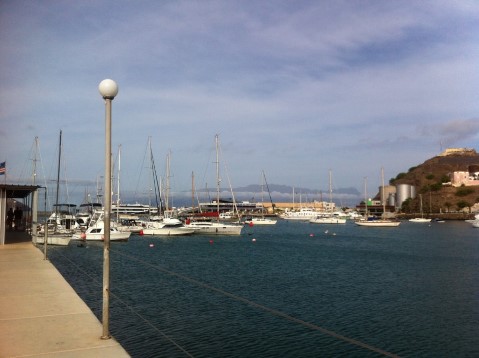 the marina for 4 euro a day. Immigration police and customs were in
the marina for 4 euro a day. Immigration police and customs were in  the port building. It took us about one hour to change euros to escudos in the local bank and complete the entering formalities. We did both check-in and check-out at the same time because I planned to depart next day.
the port building. It took us about one hour to change euros to escudos in the local bank and complete the entering formalities. We did both check-in and check-out at the same time because I planned to depart next day.
In the marina we found the sailmaker, Tuga. I think he was doing all kinds of things, not just sail repairs. He promised to fix the main sail by tomorrow morning. He did a good job and charged me 2 hours plus the material, which totaled 74 euros. I was expecting him also to repair the leech rather than pointing out that it needed to be done but oh, well.

30 October 2014
I bought a sticky Dacron tape in the local shop and with a help of Fernando we sewed the leech manually. It took us 6 hours.
The provision was rather basic. We got a bit of meat, fruits, vegetables, bread, cookies, cereal, yogurts, beer and bottled water. The diesel was cheep, 0.85 cents a liter but the quality was questionable. Water was 2 cents and was probably good for taking showers only. We got 80 liters of fuel and 120 liters of water.
We left Mindelo harbor at 1600Z or 15PM local time (UTC-1). There was no wind, and we motored for 7 hours until we passed Santo Antao. Then we reached most of the night making more than 5 kts under main and genoa.
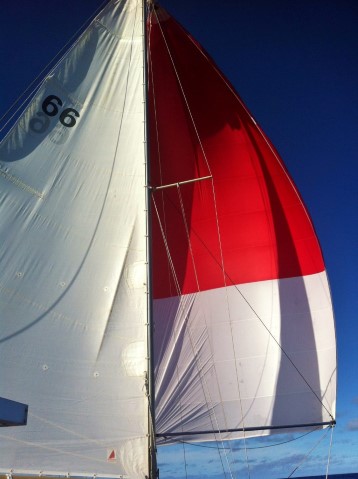
31 October 2014
By the morning the wind changed the direction to ENE and we replaced the genoa with the spinnaker. With 7-11 kts of wind, Beruta was running at 5-7 kts! This time I took some measures against the spinnaker furling around the forestay. I ran the genoa halyard tight parallel to the stay at some distance from it. This saved us from a headache afternoon.
The joy ended when the wind gusted to 12 kts and the damn autopilot was not able to hold Beruta on course. The boat moved into the wind, the spinnaker collapsed when the wind became abeam, breaking the spinnaker pole. F..ck! If not the genoa halyard, we would have had spinnaker furled around the forestay again and who knew if we were able to unwind and pull it down this time.
The sun was almost at the horizon, so I decided to postpone the repair of the pole till the morning. For the time being, I hoisted the genoa. The speed was also not bad, 5-6 kts with the wind around 10.
For the last 24 hours we made 126 miles. The distance to Curacao was 2,577, approximately three weeks of sailing. You may see Beruta's position at 2150Z on this chart.
Time for glitches was for ACR Electronics' AIS. It had been beeping all night in random intervals 3 times signaling "AIS alarm: 12 volts!". Supposedly, it meant "low battery" or a similar problem with the voltage, i.e. abnormal voltage. The AIS had never done it before. Even when the batteries were indeed low. Disregards the annoyance, it seemed to work properly, although there were no other ships around. Power cycling the device had fixed the issue. I wondered if it would happen again in the future.
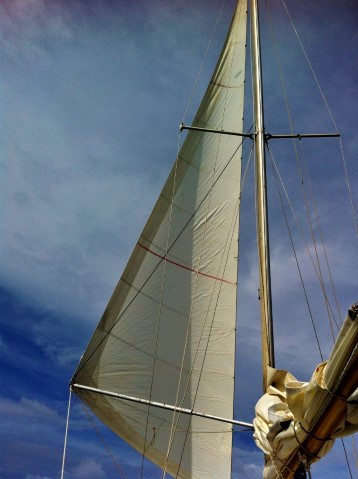
1 November 2014
After the breakfast consisted of yogurts and muesli, I began fixing the spinnaker pole. With a grinder I cut the broken end of the longer piece, drilled a couple of holes in it and reinserted it into the other tube of a larger diameter. For a genoa, the size of the pole was the same but for the spinnaker it became a little shorter.
We could hoist the spinnaker again but I decided to chill out and sail under the main sail. The speed was 4-5 kts.
Last night we collected four relatively large flying fishes from the deck and for the lunch I made a fish soup.
By the night the wind increased to 14-16 kts. I took two reefs on the main to minimize the weather helm and make a steering job easier for the autopilot. We did not want to break the main boom the same way during accidental gybing. Yes, I had a boom brake and a preventer but better be even safer, I think, especially after the previous trouble.
2 November 2014
At 0600 I started the engine to charge the batteries. There had been very little sun a day before and the following wind did not contribute much to Beruta's electrical needs. 4 hours seemed to be a good period to do that.
In the morning I received the weather faxes for the next 3 days. 15-20 kts tail wind continues. Beruta's position at 0625 can be seen on the chart.
Before the sunset black clouds appeared on the east possibly suggesting a squall or two. I decided to change the half main for the full jib. It would be easy just to drop it if the wind gusted strong. First, we took the main down. Right after that the wind increased to 25 knots. We waited for perhaps further development. The clouds moved slowly. We were motoring for the time being. After 30 minutes or so, it appeared that nothing bad was going to happen. We put the jib on the spinnaker pole. The apparent wind was in the range of 15-22 kts. The speed was 5-6, sometimes 6.5. The autopilot also liked the changes in the center of the sails. It steered more gentle and more precise despite the big waves. The dinghy at the stern was racing with Beruta, sometimes winning the race!

3 November 2014
What we had seen yesterday evening was the tropical wave. It showed up on the meteorological charts only today. It appeared that we were riding the top of the wave, which was located just south of us, and we would continue so for the next 3 days. The wave moved slowly, almost at the speed of Beruta. The wave brought lots of clouds, 20-25 knot wind and 10-foot waves.
The definition of a tropical wave is an elongated area of the low pressure that is moved from east to west by Atlantic Highs centered near Azores or Bermuda. The area is normally associated with clouds and rains. It may develop further into a tropical disturbance and subsequently into a tropical depression that may in its turn become a tropical storm or even a hurricane. It is called a wave because it looks like a wave on an isobar chart. See the example.
I explained all the above to Fernando. We also talked about aerodynamics and sails. When discussing an atmospheric pressure, I had to explain the gravity and the acceleration of free-falling. Fernando was shocked that a heavy rock and a light hair would fall down together covering the same distance with the same time in a vacuum. We talked about a lifting force and a drag, momenta, sailing directions, a boat stability and so on.
Beruta's position at 0635 can be seen on the chart.
4 November 2014
Interesting day - we caught tuna! Our  great fisherman, Fernando, first spotted "a shark" following the dinghy. Then when he tried to film it on his GoPro camera, he found other smaller fishes under Beruta. The last thing was to relocate the bait, pink plastic calamari, from 50 yards off the stern to the bottom of the boat. I put the shark in quotes because at the end we were not so sure. On his GoPro recording we briefly saw three big fishes which in fact could have been large tunas, almost the size of the dinghy! Something to think about when we take a morning shower by trawling ourselves behind Beruta on a short line.
great fisherman, Fernando, first spotted "a shark" following the dinghy. Then when he tried to film it on his GoPro camera, he found other smaller fishes under Beruta. The last thing was to relocate the bait, pink plastic calamari, from 50 yards off the stern to the bottom of the boat. I put the shark in quotes because at the end we were not so sure. On his GoPro recording we briefly saw three big fishes which in fact could have been large tunas, almost the size of the dinghy! Something to think about when we take a morning shower by trawling ourselves behind Beruta on a short line.
5 November 2014
In the weather forecast, the tropical wave would move with us for the next two days with the same wind and waves but dissipate on the third. That day another two tropical waves appeared approximately 10 degrees behind us. One was located south and another north. I wonder if they could combine in a large wave eventually. If they moved slowly we might never see them, especially if they would dissipate the same way as the previous wave. The pilot charts say that in November most tropical cyclone form closer to the Caribbean sea or in it. So theoretically, this wave could become a cyclone when we both arrive to the Caribbean.
6 days passed since we left Mindelo. 750 nm made, 1,827 nm to go to Curacao, and to the first Caribbean island, Barbados, 1,277 nm. Beruta's position at 1625 can be seen on the chart.
6 November 2014
In one week we covered 876 nm or made 125 nm a day, meaning that on average our speed was 5.2 kts.
The tropical wave was still moving with us as you could see on this chart. Beruta's position was taken at 2130 and the location of the wave was for 2400. You might see that the center of the wave was only one degree of a longitude ahead of us. Tomorrow night it would probably pass us completely (see the chart).
So far we had not had much rain, just clouds, few small squalls and little sun. The apparent tail wind was 15 kts, increasing to 20 during the squall and calming down to 10 after it. Beruta sailed under the jib on the spinnaker pole.

7 November 2014
Bad luck fishing - two mahi-mahi and both were gone. Damn it!
We began seeing Sargasso weeds, even tried them and found eatable.
Today we made 1,000 miles. The tropical wave was gone. The skies cleared and the wind calmed down to 10 kts.
For the first time since we left Sao Vicente, I saw a boat - it was a sailboat, approximately 3-4 nm northwest from Beruta. It was not displayed on the AIS screen of chartplotter. I turned on VHF and press a transmit button 3 times. After that I heard "Sailing vessel Beruta, sailing vessel Beruta. This is..." I did not get the name of the French boat. Two ladies were delivering it from Cape Verdes to Martinique. They left a day after us, but they were faster because they had a bigger boat. I joked that if they did not work, we could have had a boat party in the middle of the Atlantic.
8 November 2014
Another ship today, this time it was a cargo one going SSE about 7-8 miles NE from Beruta.
We sailed with full sails,  butterfly making 5-6 kts.
butterfly making 5-6 kts.
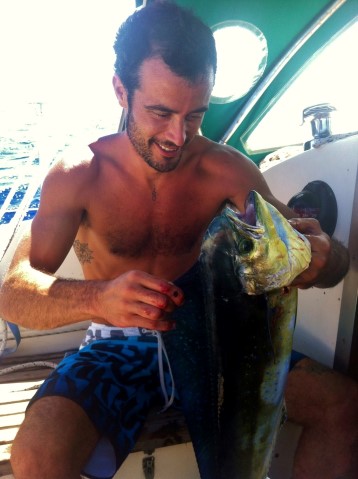
9 November 2014
Big day today - we caught fish! The greatest fisherman of all times, Fernando, was more lucky than I two days ago. I had just finished boiling potatoes and was about to open a meat can. But no, we had fried mahi-mahi!
Another milestone - we covered half the distance from Cape Verde to Curacao - 1,288 nm.
10 November 2014
The radio fax signal was becoming weaker and weaker every night. The wind arrows was impossible to count but at least I could see the isobars and tropical waves. On the tropical cyclone fax I could spot the rectangular area with a black frame meaning that there was no hurricane activity in the Atlantic basin.
Our position at 1235 can be seen on the chart.
The wind was around 15 kts in the day. We used just the genoa but by the evening it subsided first to 10 and then to 5, so I had to take the sails down and use the engine.
11 November 2014
After 6 hours on the motor, at 0400 I hoisted genoa again. The wind was 8-12 kts, the speed 4-5. In the morning, I also raised the main. The speed became 5-6.
550 nm was left to Barbados and approximately the same from there to Curacao. You may see Beruta's position at 0700 on the chart.
Afternoon we had an interesting encounter. After lunch (fried mahi-mahi with boiled rise) I and Fernando played chess as usual. The score was 1:1. I played without a queen to make the game more equal. Losing the second game, I went down to the cabin to make mate tea. When I came back, 120° to starboard in a cable or so, I saw a power boat (like a big fisherman's one) going straight to us! Oh-oh. Too bad we did not see it in advance. It was good-looking vessel, fresh paint, with a three color flag, similar to the Russian and a name clearly displayed on the topside. Our AIS did not beep meaning that the vessel was not shown there. I checked the chartplotter. Indeed, there were no ships around us. Hm... I turned on the VHF radio and pressed the "magic" button three times. Right after that "the fisherman" stopped! "Wrong password, damn it!" I thought later. Given its course, it was heading towards French Guinea or Brazil, 600 nm away from its location! It seemed like a bit distant for fishing. We were worried a bit. For as far as we could see, it remained in the same place until it disappeared behind the horizon an hour later. After a sunset, fearing that it might follow us at night, we made some precautions. I set the AIS silent mode to stop transmitting our coordinates and did not turn the running lights. I was also thinking to change the course.
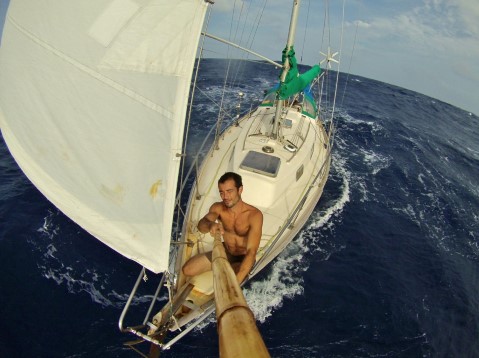
For the first night we kept watches all the time. We even began discussing what to do in a possible pirate attack. We prepared a script of what to say on the VHF radio to let the pirates know that we had a satellite phone and an SSB radio, and we had already spoken to the nearest coast guards and the Navy. We could also activate SOS signal on the EPIRB and broadcast the AIS "Pirate Attack" message. I got the speargun, the only powerful weapon on board and emptied the bottle of rum for use as a gasoline-filled bomb. When I was removing the plastic cap, I accidentally broke the neck of the bottle and later stepped on a piece of glass cutting my foot. That was the only bad consequence of the mid-Atlantic encounter.
12 November 2014 (Wednesday)
In the morning I came to a conclusion that the boat that we had seen yesterday was indeed "fishing" but the fish they were looking for was... hm, not us? Might be they were waiting for a similar sailboat? Perhaps, to exchange some goods, perhaps even a contraband. I assume that the reader is certainly aware that the captain of Beruta is a well known "big international drug smuggler"? If not, then read this story in my logbook. Of course, they were waiting for me!
At night, we had another tropical wave and some heavy rain but the wind was not too bad.
For the last 24 hours, we made 131 nm. It appeared like the best daily distance during our voyage. No doubt we had wanted to get away from the "fisherman" as fast as we could.
Less than 400 nm were left to Barbados. We would arrive there Saturday evening. If we continued the course, we could have made a stop in St Vincent late afternoon on Sunday.
I checked the fuel level in the tank. It was 18 gallons. We used 14 since the departure from Cape Verdes.
In the afternoon, we talked about tropical cyclones and meteorology. I made another attempt to explain Fernando some physics surrounded this phenomenon. We spoke about prerequisites of hurricane formation such as warm sea water, hence, air convection, initial pressure disturbance such as a tropical wave, Earth rotation and Coriolis effect on the air mass that created circulation around a low pressure area, enough moister to cool the warm air down up in the atmosphere, release the energy and further reduce the pressure, and favorite high-level winds to keep "the pump" working. We also discussed the differences between tropical and non-tropical cyclones, particularly, the frontal system that was attributed to the later one.
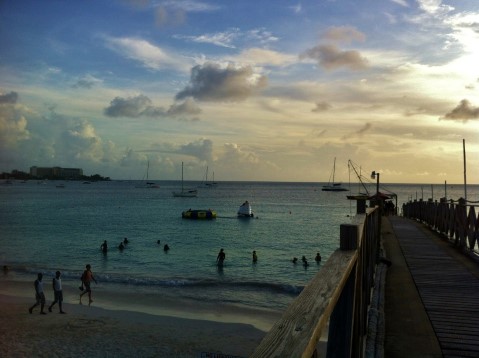
13 November 2014
Since we passed the 50 longitude, the wind became weaker, 4-8 kts at night and 8-12 during the day. Now we used the engine not only to charge the batteries. We were still ok in terms of available diesel to finish the trip without a problem.
Lots of 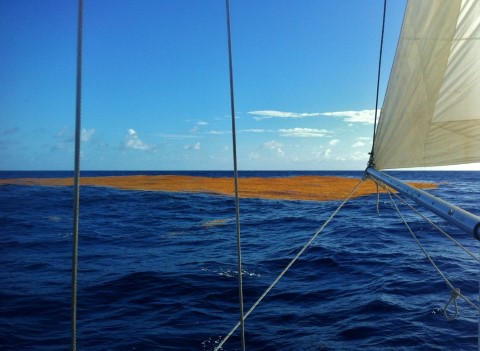 Sargasso weeds!
Sargasso weeds!
14 November 2014
Today I changed the course to Barbados. We wanted to get fresh food.
You may see Beruta's position at 0710 on the chart.
15 November 2014
Around 0200 there was a squall. The wind blew 30-35 kts for almost an hour. I took the genoa down and was manually steering under half main because the autopilot's motor was stalling during the gusts. There was no rain though, the heavy cloud was a bit south of Beruta. After the squall, I started the engine to charge the batteries for about 6 hours.
1900 we dropped the anchor in Carlisle Bay near the Boatyard bar's bridge. They charged 16 euro per person per day for leaving the dinghy in their bridge. This was not the docking fee but the money that should have been spent in their bar for drinks and food. They had free internet. Tomorrow we would leave to Curacao with a possible one-day stop in Bonaire. I plan to arrive to Curacao November 21.
16 November 2014
I wake up at dawn, added 17 gallons of diesel to the tank, filled empty bottles with fresh water from a canister for cooking and lifted the anchor.
We left at sunrise, 7 o'clock local time (UTC-4). It was 555 nm to Curacao from Barbados, roughly 5 days of sailing. Today we motorsailed because the wind was weak after squalls and I did not want to risk the sails due to numerous heavy clouds here and there. We used only genoa, which was easy to drop when the wind gusted.

17 November 2014
At night the sky cleared but the wind increased to 20 kts. I barely slept because Beruta was going through Grenadines passing between Bequia and Mustique or more precisely between Cactus Cay and All Awash Island. The distance between them was about 1 nm, which was of course, more than adequate but someone had to watch that we were in the middle of the passage. The current changed in the shallow bank of the islands and magnetic course adjustments were necessary. I used three chartplotters (Raymarine with Navionics charts, my iPhone with iSailor app and the laptop with OpenCPN software) each with an independent GPS to confirm the position of the islands. They all showed the same on different charts meaning that the charts probably were ok. I could also see the dark contours of the islands in the night skies. Ironically the half-moon appeared from a cloud right after Beruta passed the islands. I was also afraid of possible fishermen boats in these banks. Indeed, I saw one later without AIS.
In the morning there was one more squall but then the weather improved. I set half main and genoa in a butterfly manner and Beruta made 5 kts through the water in 10 kt wind. For the last 24 hour we covered 114 nm. Beruta's position at 0740 can be seen on the chart together with the GRIB file. For the first time we experienced strong (1 kt) head current yesterday and later on today.
18 November 2014
What a busy day! At night there was a squall that tore a genoa. The wind had done it after I lowered the sail. The fabric stuck in the running light mounting SS plate on the pulpit and a gust of wind finished the job. I replaced the genoa with the jib and in the morning worked a few hours as a sewing machine. I glued the genoa on both sides with a dacron tape and then 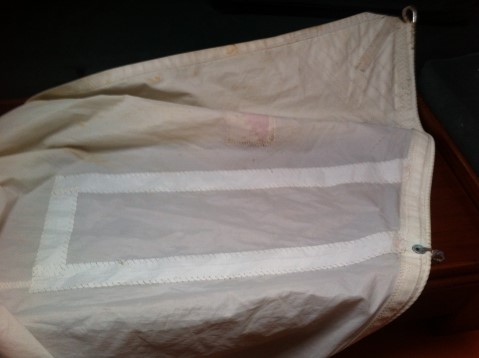 stitched it along the edges of the tape.
stitched it along the edges of the tape.
The same morning autopilot drive started making squeaking sound and later stalling the motor for no reason. It had happened before. I knew what that meant. Water got inside the motor and corrosion did the rest. I replaced the broken drive with a spare and spent the second half of the day fixing the defective unit. I replaced the motor with a new one. After cleaned, lubricated and assembled the drive putting back all invented by me plastic bags and tapes here and there to minimize the chances of moister getting inside, the drive did not work! The motor gear had not probably meshed properly. I heard that it was spinning but the drive arm did not move. I had to take it apart again and realign the gear. I completed the job when it was already dark.
When I was in the middle of the autopilot repair, there was another squall that had torn away one of the luff grommets on the main sail. I lowered the sail but fixing was left till next day.
Speaking of repairs at sea during our last days of Atlantic crossing, I should have also mentioned that a day before Fernando lost his balance and broke  the LED holder plastic bracket on the Ritchie compass. I glued it temporarily in place but it had to be replaced as well. I would try to contact the manufacture and see if they could ship it to me.
the LED holder plastic bracket on the Ritchie compass. I glued it temporarily in place but it had to be replaced as well. I would try to contact the manufacture and see if they could ship it to me.

19 November 2014
After morning yoga and breakfast, I put a new grommet on the main and stitched a plastic slider to it. This had completed a series of recent repairs. The weather did not change though. Squally clouds continued appearing in the skies. It was the end of a hurricane season in the Caribbean sea but the rainy one might continue well till the end of December or even January. Therefore, it was safer to sail just under one jib on a spinnaker pole. At night the wind was usually strong, 20 kts and more. It was enough for Beruta to make its 115-125 nm daily. During a day I helped her for a short period with an engine charging the batteries at the same time. We only used 5 gallons of fuel since we left Bridgetown.
20 November 2014
We passed Los Roques Islas at night. I did not turn the running lights near Venezuelan National Park. There have appeared to be a village, hence, fishermen, which could also be pirates. One never knew. We were just 15 nm from the shore. Our position at 0700 could be seen on the chart. It was 60 nm to Bonaire and 95 to Curacao. If we did not make any stops, we could even arrive today to Spanish Waters, given Curacao local time (UTC-4).
At 2145Z we were at the south point of Bonaire. This was my first time sailing near this island in a day time.
An hour before sunset we caught a relatively large Mahi-Mahi. This one was a strong fighter! We used lots of rum for a narcosis.
When we approached Curacao, it was already dark. The wind calmed down, and we were entering Spanish Waters under the sky full of stars. In Santa Barbara resort at the neck of the lagoon, there was a live band playing latino style music. Tourist were dancing. I felt being back home in the Caribbean!
21 November 2014
At the anchorage there were many boats and it took us some time to find a free space. We dropped the anchor at 0030Z or 20:30 local time.
Therefore, considering a short stop in Barbados, it took us a bit more than 21 day to cross the Atlantic. Till next voyages!
All pictures from the fourth Atlantic crossing are on Google Photos.

